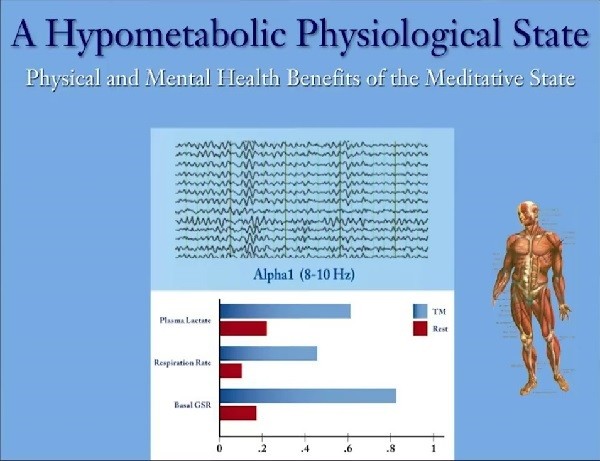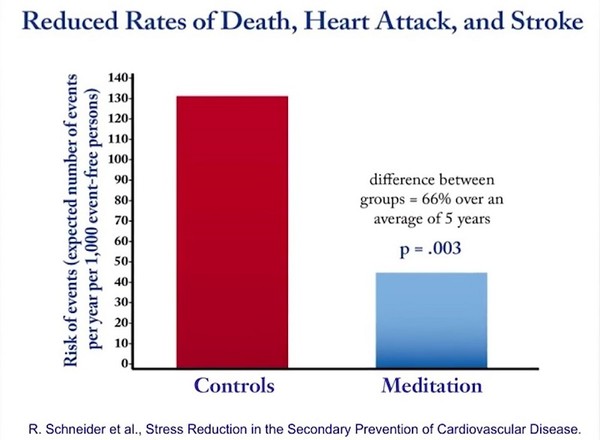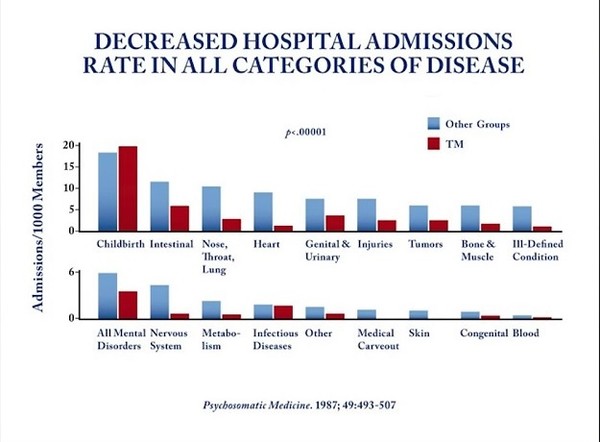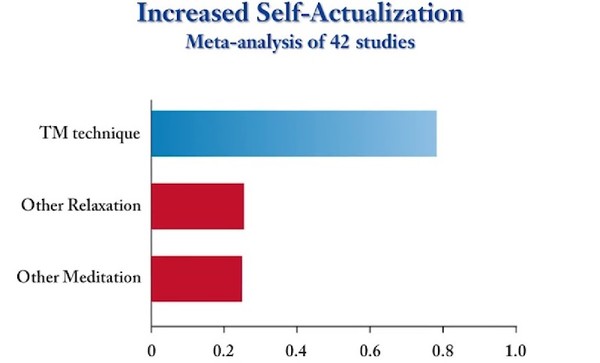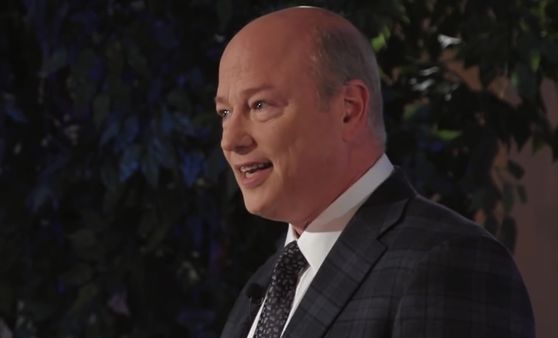
Evidence based Meditation - An introductory lecture on the benefits of meditation by Quantum Physicist John Hagelin
Hello, I am John Hagelin, quantum physicist and teacher of the Transcendental Meditation program. We're going to be talking about Transcendental Meditation...what it is, what it is not, why millions of Americans would do it, and millions more throughout the world.
Modern science and our physical universe
But to really understand meditation, to understand the mind, to understand consciousness, we need to invest a minute in understanding a little bit about the nature of reality.
Modern science, over the past fifty years, has revealed that our physical universe is structured in layers of creation...layers of creation.
From superficial, macroscopic, to microscopic.
From the surface sensory world of day to day experience, day to day objects, to the deeper world of the atom and quantum mechanics and quantum field theory.
And this inward exploration began with the study of what's called Classical Mechanics, the study of the world of macroscopic objects, or day to day world, but quickly went to the discovery and exploration of the atom, the world of what's called Quantum Mechanics.
And deeper than the atom is the atomic nucleus and subnuclear particles. This is the world of Quantum Field Theory.
And then finally the recent discovery of Unified Field Theories. Unified Field Theories - super string theories - reveal the fundamental unity of life.
They show, as this chart reveals, that at the basis of our diverse universe is a single universal field of intelligence...the fountainhead of all the laws of nature, and the source of all order displayed throughout the universe.
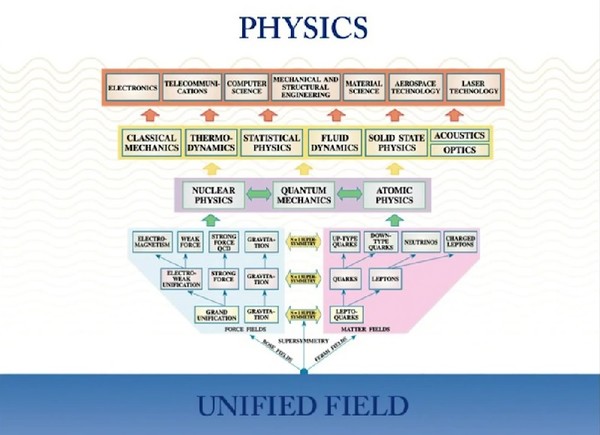
Now from the scientific context, what is meditation? What is consciousness?
We know today that the human mind, human consciousness, is structured in layers, in parallel to the structure of the universe...human mind is structured in parallel with the structure of physical reality, which means there's surface levels of mind...active, thinking, choppy, chaotic mind. But deep within there are quieter and quieter levels of mind, they are more silent, and they are more powerful levels of the thinking process.
And from this perspective, meditation, properly understood and properly practiced, is a technique to take out outwardly directed attention through the senses, powerfully within, to experience and explore deeper levels of mind...quieter and quieter and quieter levels of the thinking process, (as this chart shows).
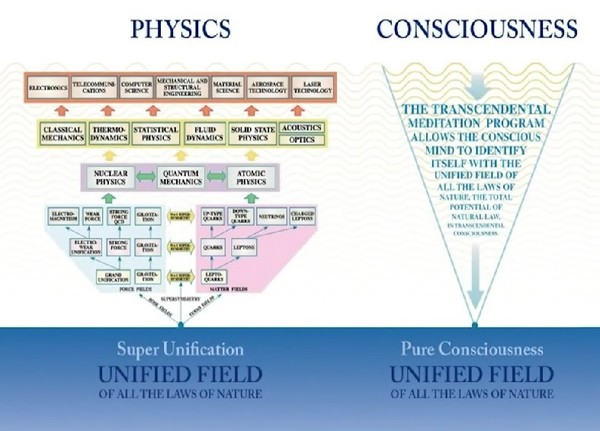
The meditative state a state of “Restful Awareness”
And this inward flow of the mind culminates in the experience of complete silence, the direct experience of this fundamental unity, this unified field at the basis of mind and matter.
Now not only is this extremely interesting philosophically, but it has profound practical results for our health, for brain development, for our life.
This meditative state, achieved through TM, transcending, is a fourth state of human consciousness, identified by modern physiological science. It's called a "hypometabolic physiological state." (American Journal of Physiology 1971) It's not waking, not dreaming, not sleeping...it's a fourth state of consciousness, the meditative state.
And hypo metabolic physiological state is just doctor talk for "a state of deep rest," in fact a state of rest that is much deeper even than sleep.
And this published research compares the rest through Transcendental Meditation - shown in blue - with the rest that is gained through conventional relaxation, rest, or sleep. And it shows that the level of rest through TM is much more profound. And deep rest is the most powerful antidote to stress and anxiety (Journal of Clinical Psychology 1989).
Heart disease and blood pressure
And the deeper rest of Transcendental Meditation is much more effective at dissolving stress and anxiety that conventional relaxation, other forms of meditation, or sleep. It's very, very significant, according to this meta-analysis of published studies, conducted at Stanford University...very powerful study. Now stress is important for health...stress causes or complicates most disease, including heart disease. If you look at the risk factors for heart disease, the number one is high blood pressure. And the deep rest of Transcendental Meditation lowers blood pressure more effectively that most hypertensive drugs, and much more effective than other forms of relaxation, or meditation. Indeed, in April the American Heart Association came out with a major study, a proclamation, a policy stating that doctors should consider recommending TM to all patients with blood pressure over 120 mmHg...which is most of you. [laughter] (Hypertension 2013) (Archives of Internal Medicine 2006)
Arterial sclerosis
And that means...and they also were clear to point out that no other meditation, relaxation, or alternative therapy actually has been shown to be effective against high blood pressure. So this is a really remarkable result, and it is unique to TM.
There are other risk factors for heart disease. There's arterial sclerosis, and the deep rejuvenating rest of Transcendental Meditation has been shown to unclog clogged arteries.(Stroke 2000)
Diabetes
And in addition to that, diabetes is a very important risk factor for heart disease as well. And one of the most amazing recent results, which really stunned the medical community...and got them very enthusiastic, they issued an incredible press release that went around and around the world...showing that TM actually normalizes, or helps to normalize, insulin resistance, which means it helps to reduce diabetes.(Archives of Internal Medicine 2006)
TM, heart attacks, stroke, and death
Bottom line though, when it comes to heart health is "What is the effect of TM on heart attack? Or stroke? Or death?"
And here the results are perhaps most profound. In a 9 year study, funded by the National Institutes of Health - a random controlled assignment study, blue chip, gold seal study - people who were at risk, had high blood pressure, were at elevated risk of heart disease, experienced a two thirds (2/3rds) drop, in comparison to controls, in the number of heart attacks, stroke, and death. That two thirds drop in heart attack was more significant than the effects of medicine, the effects of diet, the effects of exercise, and both groups - the meditators and the controls - were taking their medicine, and they were struggling with their exercise and diet, but the real difference between the groups that led the drop, comparatively two thirds reduction, was the TM. And another thing...after this 9 year study, 80% of the people who had learned TM were still doing it. How many people do you think were still doing their diet and their exercise regimes? Almost none. And the difference is that TM is fun to do! Exercise, debatable. Diet, no way. (Hypertension 1995) (Circulation: Cardiovascular Quality and Outcomes 2012)
The medical benefits of the TM program
This was also big news that went around and around the world, and it was just an amazing finding...the research gets stronger and stronger every day. Now there is more to health than heart disease, and one of the remarkable major studies that have been done - there have been about 700 almost, published studies, on the medical benefits of the TM program. This study looked at all disease, and showed a marked reduction in every major category of disease, just by adding 20 minutes of TM, twice a day. Now if you have good eyes you might spot that fact that there is one category of disease here that wasn't reduced, and that is childbirth, and that is childbirth, but I would argue childbirth is not actually a disease. The meditators were having as many babies as the non-meditators. Now here's one final note to put on the subject of help. You know, stress, fatigue wear and tear at the body, so that over the course of a lifetime, people start to look aged, they start to age, their stamina, their sharpness starts to degrade...That is due to the wear and tear caused by stress. The profound, rejuvenative rest of TM and the dissolving a of stress through that technique results in a slowing of the aging process, which is very significant...such that people who have been meditating regularly, twice a day for five years or more, tend to have a bodily age, physiological age, 12 to 15 years younger than their chronological counterparts. That's a big deal to anyone my age, or older...12 more years of high quality, healthy living. (Psychosomatic Medicine 1987)
Meditation and brain
I'm an educator, and a brain researcher, and I'm even more excited about the effects of TM not just on the body, but on the brain and on brain development. Now, if we look at again what meditation is from the modern scientific perspective, and what the classic definition of meditation is, meditation from the yoga tradition, which is where this comes, thousands of years ago, there are different levels of mind, as we have seen. And from the surface, active mind, to deeper, quiet, settled states of mind, to absolute silence within the mind. And this next chart shows that those three levels of mind - active, concentrating, focused mind, silent self-reflection, or the meditative state - have a completely different style of functioning of the brain. Completely different electroencephalograms - firing of the neurons looks completely different. These three levels of mind correspond to the three major categories of meditation discussed in the scientific literature. Outward, active thinking, concentration, focus, is one category. A quieter category called mindfulness often in the literature, involve various techniques of quiet self-reflection. The brain looks completely different. The mediative state, through TM, so called transcending, pure consciousness, Samadhi...a completely different style of functioning.
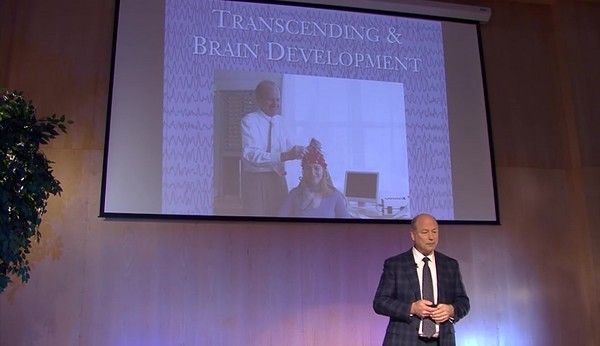
Cerebral coherence
And if you look carefully at it, what it is, is the whole brain functioning in a completely integrated way, in a highly coherent way. Front of the brain, back of the brain, temporal lobes, parietal lobes, left and right hemisphere, the whole thing in concert. And that orderliness, coherence, that integrated functioning of the brain, translates to coherent, orderly thinking, and coherent, orderly thinking translates to coherent, clear, orderly speech, and orderly, purposeful, effective, active, dynamic action. And that means successful action, and that means fulfilling action. And if you want to look at it more graphically, take a look at the brains here. On the left, this is a subject sitting with eyes closed rest. And the little dots represent the electrodes places on the scalp, looking at the electrical activity of the brain, and every once in a while there's a bar connecting those neighboring dots...not very many on the left. When you see a bar connecting neighboring dots on the scalp in means those two parts of the brain are talking to each other. They're functioning in some kind of intelligent, coherent, orderly way, not totally chaotic, not totally scattered, but pretty scattered, as you can see from this picture.
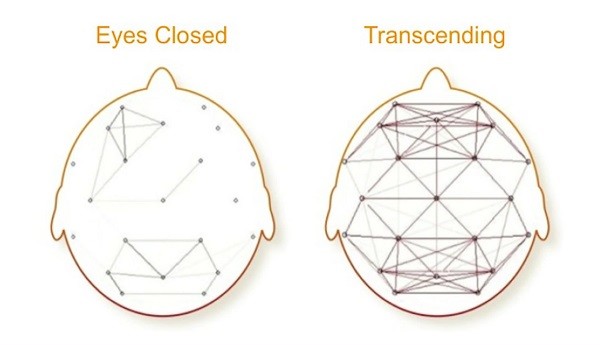
On the right-hand side in the very same person, three months later. They've learned to meditate, and this is during TM. And you see in this deeply settled state of mind, the whole brain is functioning in this incredibly coherent way. You don't see that in waking, dreaming, sleeping, hypnosis, in any other state but this meditative state. And why that's good, not just interesting for a brain person, but why that's good, is that orderly brain functioning correlates with rising intelligence...IQ, learning ability, academic performance, creativity, alertness, reaction time, more reasoning, psychological stability, emotional maturity.
Everything good about the brain depends on it's orderly functioning. And now orderly brain functioning can be systematically, easily, effortlessly, joyfully increased in anyone of any age, from 10 years old, where a child can easily sit and master, and deeply enjoy this relaxing, natural effortless practice, or even the elderly, who are institutionalized in nursing homes.(Int J Neurosci. 1982)
Lets talk about acute stress
Now, I want to talk for just a moment about acute stress, and can meditation, can TM, tackle the most acute stress. Let's look at veterans returning with Post-Traumatic Stress. This is a major problem of our age. PTSD results when the fear center of the brain, due to some overwhelming stress, some shock, gets frozen in hyperdrive.
And the normal restive sleep is typically not enough to shut it down. The deeper rest of Transcendental Meditation, the meditative state, can de-activate, can calm the fear center even in the very first meditation.
And sometimes for people it can take maybe a couple of months of twice a day meditation. And you see these remarkable reductions in the symptoms of PTSD. PTSD is a terrible thing that can absolutely destroy a life, and it's the worst, most acute type of stress. Even that dissolves effortlessly, in a relatively short period of time, through TM. And that is why we're seeing the modern militaries of the world - the Department of Defense, the Veterans Administration, military academies and universities in America, incorporating TM into the curriculum. As an antidote to stress, and as a vaccine inoculating the troops against the ravages of war stress...so scientifically established now, is its effectiveness.
ADHD
And one other final area, as an educator I have to mention, and that is that so many of our children, in our increasingly stressful world - we're living in an epidemic of stress, according to the Surgeon General, and that has negative effects on health and brain functioning - so many of our children have stress, and ADHD is a symptom of today's modern stress. Millions of children diagnosed with it, millions of children medicated for it, but very little to do about it. Suddenly now, with TM, a technique to restore balance in the brain, to dissolve deep stress, we find, in about 12 weeks, according to the latest study, of twice daily meditation among junior high school students, maybe 12 minutes or so, twice a day, a normalization of the brain function and marked drop in the symptoms of ADHD. And that is why principals, superintendents, parents, schools all over the country and all over the world are incorporating TM into the school curriculum...involving around the world close to a million students today, and hundreds, at least 400 different schools. And it takes powerful benefits and documented research to motivate a principal or a teacher to try something so, what? Innovative. And the results are spectacular.
Self-actualization
I've talked a lot about stress today… I just wanted to mention that TM is more than relief from stress. It's about the holistic development of the brain, the total development of the personality, the integrated functioning of the person - mind, body, relationships, behavior - and that is called in the literature "self-actualization."
You see a marked improvement in what's called development of the mind, development of consciousness, self-actualization, through TM, that you do not see in other systems of meditation. Only because they don't go quite deep enough. So that's it. (Journal of Social Behavior & Personality 1991)
Learning it
The TM program is learned very easily in a series of simple steps. You have just graduated from Step One. You have heard and hopefully understood an introductory lecture on the benefits of meditation.
The next step would involve a second talk with one of your local teachers, certified teachers, where they'll talk more specifically about the practice, about the mechanics of it, about how it's different from other types of meditation, and why it's so easy, so effortless, so universally effective.
And then there are several 4 subsequent meetings, if you choose to proceed, where you sit for instruction, over 4 consecutive days.
And after those 4 days of instruction you are a master meditator. You are starting to enjoy the full benefits of your daily practice, twice a day. And that's really all there is to it, except to note that we have a very rich follow up program that everybody's entitled to.
Once you meditate you can (go) to any teacher, any TM center in the US, or in the world, sit for free with a TM teacher, have your meditation fine tuned, have it checked, gain deeper understanding. All that is part of the TM program. Highest priority of any teacher of TM is tending to the people they have already taught.
Next step, again is find a local teacher you can get in touch with a teacher at www.TM.org. And I certainly hope you will. Thank you very much.
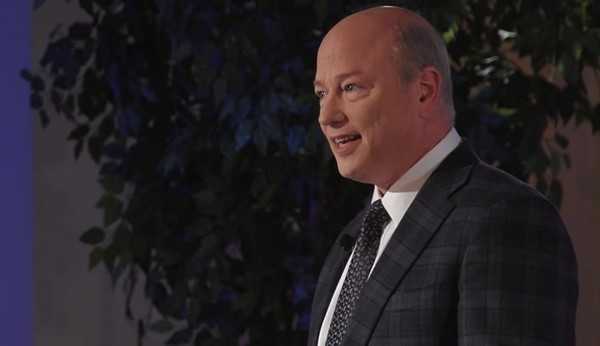
https://www.ncbi.nlm.nih.gov/pubmed/10700487



 David Orme-Johnson, Ph.D. - Truth about TM
David Orme-Johnson, Ph.D. - Truth about TM 